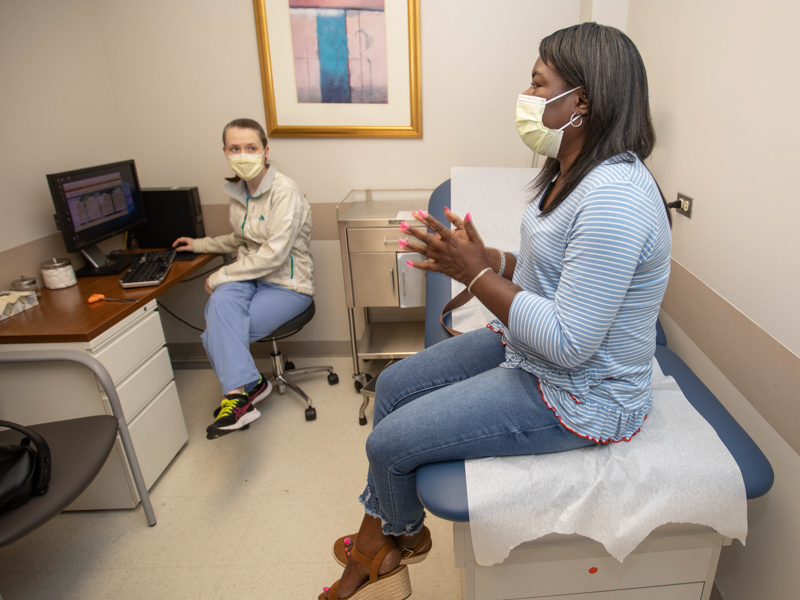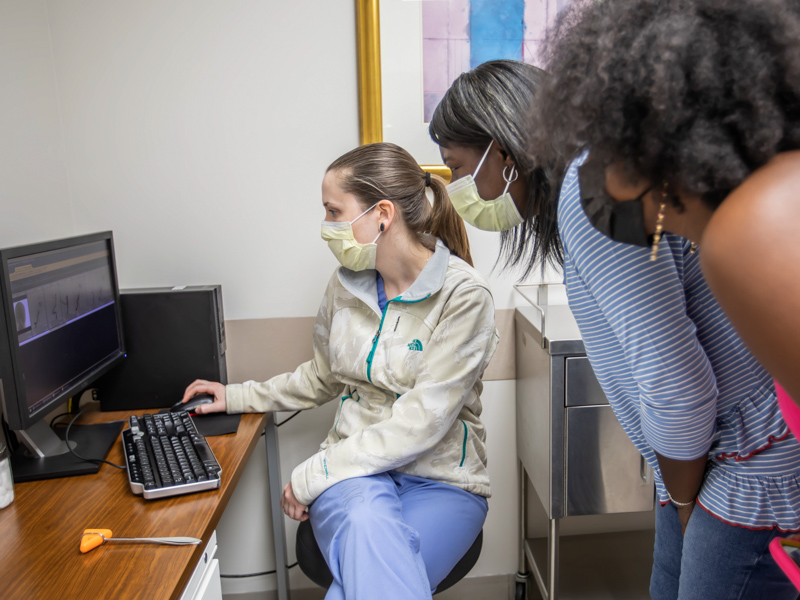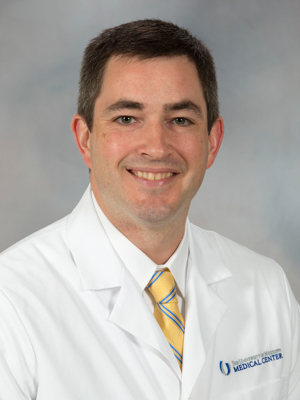Minimally invasive procedure repairs brain aneurysms at high risk of bursting

In need of a new kidney, Felicia Beasley had a MRI at the University of Mississippi Medical Center as part of her preparations to get on the transplant waiting list.
The scan revealed not just details of her polycystic kidney disease, but something she never expected. She had not one, but two brain aneurysms. This particular aneurysm occurs when the wall of an artery or vessel in the brain develops an abnormal bulging or ballooning. That area fills with blood, and it can rupture and cause cognitive loss or death.
It must be surgically repaired to block the flow of blood to the aneurysm bulge.
“I was in shock,” said Beasley, who is disabled, on dialysis and lives in Brookhaven. “It was very surprising.”
Her caregivers advised her to give the aneurysms prompt attention and referred her to Dr. Allison Strickland, an assistant professor in the Department of Neurosurgery. “She did the ‘WEB’ on me,” Beasley said of her April 29 procedure.
The WEB, a medical abbreviation for Woven EndoBridge System, is a tiny basket-like device made from very fine wires braided together to form a flexible, expanding mesh. Strickland used a catheter to pass the WEB device through an artery in Beasley’s arm and into the aneurysm. The WEB device sits inside the aneurysm and causes it to clot, or thrombose. The aneurysm is then not at risk of rupture.
Traditionally, a brain aneurysm has been repaired by inserting a small metal coil into it. A surgeon would place a catheter in the patient’s femoral artery in the leg, passing a coil through a catheter in an artery that runs to the brain, or would access the aneurysm by going through a patient’s skull.
Passing the web device through a catheter in a patient’s arm, however, is less invasive than going through the leg, and significantly less invasive than securing the aneurysm through an opening in a patient’s skull.

“She had a pretty good-sized basilar tip aneurysm,” Strickland said of the specific bulge in Beasley’s vessel that accounts for just 5 percent of aneurysms. “She was a great candidate for the WEB.”
Beasley’s polycystic kidney disease may have played a role because it can be associated with an elevated risk of developing a brain aneurysm. The disease is an inherited disorder that results in fluid-filled sacs in the kidneys, and it usually increases blood pressure, which can put stress on blood vessels.
Of Beasley’s two aneurysms, the larger one “was definitely at a higher risk of rupture,” so the decision was made to treat it first, Strickland said. The second, smaller aneurysm can be surgically repaired later, without using the WEB, she said.
“The reason this (WEB) device is so great is because you only have to use one for a wide-neck aneurysm,” Strickland said. The older procedure sometimes required placement not just of a coil, but also a stent, she said.
“More devices mean added risk. With this, you just open the web device into the aneurysm and it’s done,” she said. “Complications are less if you go through the arm. If you go through the leg, there’s a risk of hemorrhage that could be life-threatening.”
The procedure is done in UMMC’s state-of-the-art Interventional Radiology Suite that opened in September 2020. It offers the latest technology in a spacious, inviting treatment area for both diagnostic and outpatient procedures.

Patients receive general anesthesia for the procedure, and they stay overnight for observation in the neuroscience ICU before going home the next day.
While patients undergoing traditional catheterization through the leg must stay flat for two to four hours, “patients can get up and walk around immediately” following the trans-radial WEB performed via the arm, Strickland said.
Beasley said she liked the idea of the trans-radial WEB “because it was better than opening up my head. Dr. Strickland decided to do this procedure, and she did a great job.
“I spent one night in the hospital, and everything’s been fine. Everybody at the hospital took real good care of me.”
Strickland is uniquely qualified in the state to do the trans-radial WEB procedure. She is the first physician in the state to use the newest microcatheter, called a Via-17, to deploy the WEB device. Beasley’s procedure was the first of its particular kind in the state, and Strickland is the only surgeon in Mississippi who is fellowship-trained in trans-radial treatments.

“Having brought in Dr. Strickland, we’ve expanded our coverage of neurosurgery endovascular services,” said Dr. Chad Washington, professor and chair of the Department of Neurosurgery. “She’s been a great addition to bringing the means and approach, and the techniques we can offer our patients.
“This allows us to tailor our treatment plans. We have a very patient-specific treatment plan based on individual needs.”
The trans-radial WEB procedure is just one example of new technology used by Department of Neurosurgery providers, Washington said. “We see lots of aneurysms and probably treat 200 a year at UMMC,” he said. “Each aneurysm is different, and each has a different treatment.
“The trans-radial WEB is good for certain types of aneurysms,” Washington said. “This device, and all of our techniques, are highly specialized options we provide to manage vascular conditions.”


